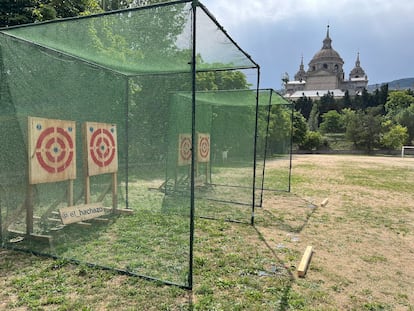From throwing axes to smashing computers: The boom in rage rooms
As the world fell apart with the 2008 economic crisis and the Covid-19 pandemic, these places have proliferated. But they might also warn of an underlying problem: we don’t know how to manage our emotions

Are we done for? It is possible that we are done for. The aftereffects of the pandemic, the precariousness of our salaries, the return to our offices after tasting the sweetness of telework, impossible rents, inflation and our lack of time for a life outside of work do not exactly make for a full and happy existence. In the face of all that, we can turn to self-help books, essential oils and lavender-scented candles or we can go for a walk in the countryside. But we can also go into a rage room and smash everything in sight with a huge hammer; perhaps that is what our bodies are clamoring for after we receive a twelfth after-hours work message or check how much a pound of tomatoes costs. And when we say break everything, we mean everything: computer monitors, screens, keyboards, tables, chairs, lamps, plates and glasses. Everything.
“This goes back to before the pandemic, but perhaps the pandemic has accentuated it: people need to release stress, but in their day-to-day lives they don’t have time to stop and manage everything that stresses them out,” explains Sandra Bueno over the phone. She is the account manager at the Kiwi Events company, which offers different activities designed for work teams, ranging from culinary experiences — such as cooking courses and wine tastings — to training activities — e.g., classes to learn how to speak in public — to more playful activities like gymkhanas and escape rooms. For some time now, the company has also included something called destructotherapy in its catalog: “It is basically an activity where people smash things.”
The company manages both the space and the objects. The participants in this activity enter a room one by one, protected by a helmet and goggles, to break everything they find there: “When they first go in, they are a little self-conscious, until you tell them that yes, they can break everything, and then they [get into it].” Sandra Bueno explains that her clients were the ones who began to demand this activity; “possibly because they saw it on television or read about it in a report from the United States.” Now, many people call the company — individuals, couples or groups of friends — to try it: “We are focused on corporate groups of 15 people or more; logistically, that’s profitable for us. If we did it individually, we would have to charge an exorbitant price.”
While they were baptized as rage rooms in the Anglo-Saxon market, the first room for breaking things was born in Tokyo in 2008. According to its creators, the space was invented as a way to alleviate the anguish around the economic crisis that was happening at the time: “To break something, as all of us know from experience, is something extremely exhilarating, and it helps bring down pent-up anger. We hope to become the new way businessmen and women relieve their stress,” said Katsuya Hara, one of the founders of The Venting Place, in an interview with the British media outlet The Telegraph. “It’s recession here and recession there. All everyone talks about is the recession,” an enthusiast of the new space told the same media outlet. “I was feeling pent-up stress and looking for a way to release some of that when I had the good fortune to come across this place.” For just over a dollar, you can smash a small cup at The Venting Place; for about $7, you can break a large plate.

In 2016, a Vice article reported on the proliferation of rage rooms in the United States. “The anxieties that [lead people to such spaces] are universal: friend drama, work stress, and family problems,” the piece said. “But, according to rage room owners, a new stressor is driving people to rage rooms: politics.” 2016 was a presidential election year in the United States; it culminated in Donald Trump’s victory. Two years later, in 2018, a similar venue opened in Madrid, Spain, called El hachazo [The axe blow]. There, the fun consists of throwing axes at a target while enjoying a drink or a soda. Its founder, Vincent Benac, a Frenchman based in Spain, knew that it was a business that could succeed: “There are more escape rooms in Madrid and Barcelona than in France and England combined,” he tells this newspaper.
Today, there are three El hachazo locations in the city of Madrid, one in Valencia and one in Murcia: “When we started we were the only ones in Spain, people came from all over the country to throw axes,” the founder says. He has a clear understanding of the venue’s appeal: “People come to have a good time. And everyone talks to me about the need to vent anger or release stress. Undoubtedly, people usually leave [feeling] much better than [when] they came in.”

Asked about why rage rooms are so popular, clinical psychologist Violeta Alcocer notes that they “say several things about us as a society. [Their popularity] speaks of the normalization of dysfunctional emotional coping strategies, which amounts to a failure in the emotional education of the population and particularly the failure of policies and resources that are supposed to offer people alternatives and effective strategies for managing difficult emotions such as anger, rage or frustration.” It is not a coincidence that rage rooms have emerged in times of crisis and are often advertised using therapeutic language.
“Anger and rage are emotions that are activated when we feel threatened, made invisible, violated, subdued and abused, and these types of situations abound in our society, both individually, on a day-to-day basis, and structurally,” the psychologist adds. Alcocer points out that many people are not aware of the issues that lead them to feel this way, so they experience the emotions and feel the urge to free themselves of [those feelings], but without having identified what the triggers are. The mental health expert believes that it is “perverse” to offer spaces for venting anger as an object of consumption: “It is very easy for the system to violate individuals if letting them break things to temporarily control themselves — without really asking what is wrong, what has led them to need to do that — is enough.”
Alcocer understands why these activities can feel so liberating, as so many participants attest after doing them: “These activities help [people] let go, but they are not strictly therapeutic because they do not offer an adequate model for managing emotions. Rage, anger, frustration and fear... are primary emotions that hijack our primitive brain and invite us to act without thinking, often from [a place of] aggressiveness.” The proper and healthy way to process these emotional states would be to activate the cerebral cortex, which the psychologist says is the most appropriate part of our brains: “We can do this by putting words to what is happening to us, identifying the things that provoke us, talking about it and looking for action plans that really help us to deal with [our] emotional state in a healthy way.” Smashing things once a month doesn’t count as an ideal action plan. Or maybe it does, but only after a therapy session.
Sign up for our weekly newsletter to get more English-language news coverage from EL PAÍS USA Edition
Tu suscripción se está usando en otro dispositivo
¿Quieres añadir otro usuario a tu suscripción?
Si continúas leyendo en este dispositivo, no se podrá leer en el otro.
FlechaTu suscripción se está usando en otro dispositivo y solo puedes acceder a EL PAÍS desde un dispositivo a la vez.
Si quieres compartir tu cuenta, cambia tu suscripción a la modalidad Premium, así podrás añadir otro usuario. Cada uno accederá con su propia cuenta de email, lo que os permitirá personalizar vuestra experiencia en EL PAÍS.
¿Tienes una suscripción de empresa? Accede aquí para contratar más cuentas.
En el caso de no saber quién está usando tu cuenta, te recomendamos cambiar tu contraseña aquí.
Si decides continuar compartiendo tu cuenta, este mensaje se mostrará en tu dispositivo y en el de la otra persona que está usando tu cuenta de forma indefinida, afectando a tu experiencia de lectura. Puedes consultar aquí los términos y condiciones de la suscripción digital.
More information
Archived In
Últimas noticias
The journal ‘Science’ criticizes Trump’s anti-renewable energy policy: ‘The US is failing to benefit from its own innovations’
Cubans hope for a miracle as dengue and chikungunya spread
The long shadow of the father figure in the films of Rob Reiner
US sanctions against jailed cartel leader ‘El Marro’ highlight Mexico’s lack of control over its prisons
Most viewed
- Christian Louboutin: ‘Young people don’t want to be like their parents. And if their parents wear sneakers, they’re going to look for something else’
- ‘El Limones’ and the growing union disguise of Mexican organized crime
- Cartels in Mexico take a leap forward with narco-drones: ‘It is criminal groups that are leading the innovation race’
- ‘We are dying’: Cuba sinks into a health crisis amid medicine shortages and misdiagnosis
- The low-cost creative revolution: How technology is making art accessible to everyone











































